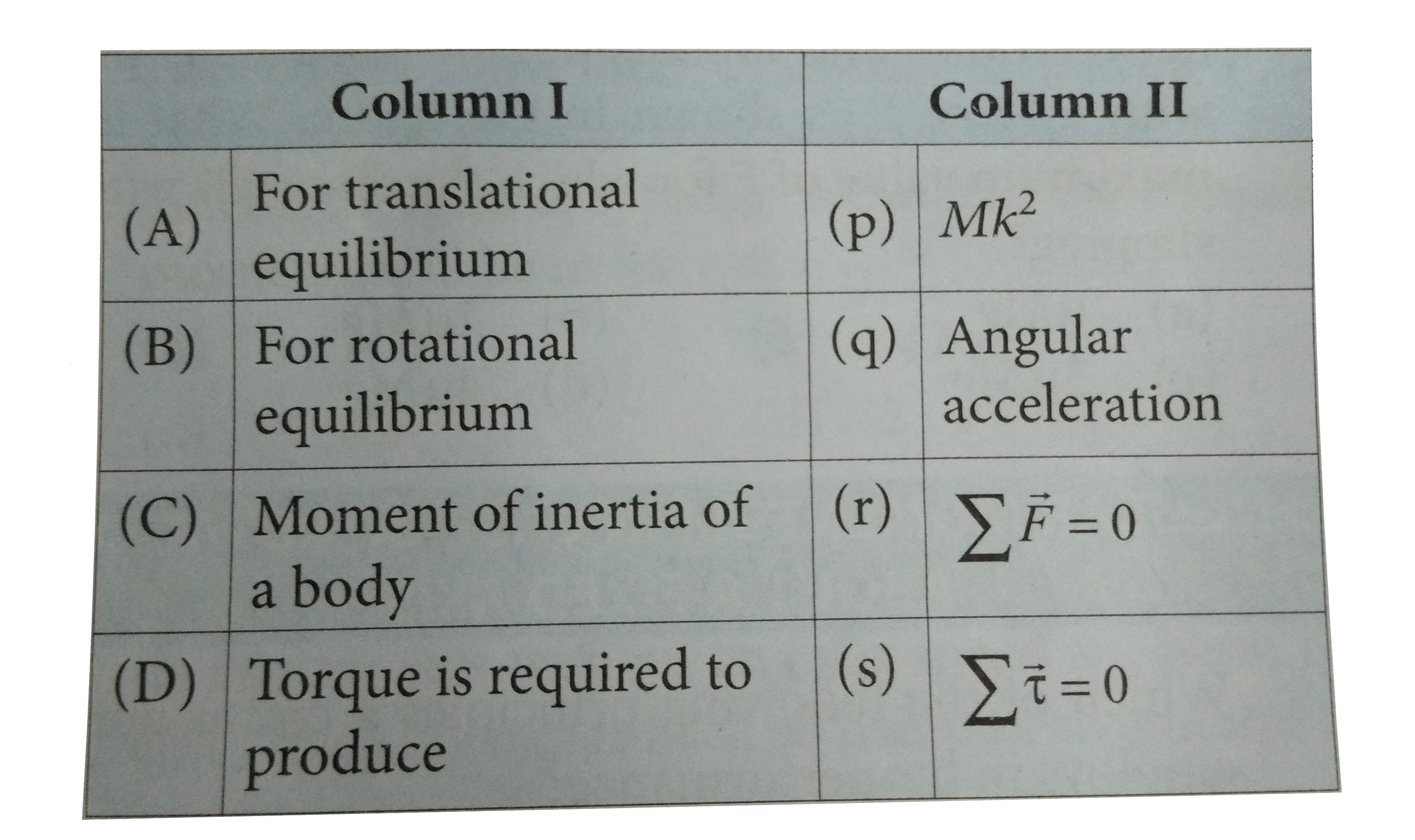Match column A and B:
A - MineralsB- plants1.Sii.Diatoms2.Naii.Halpohytes3.COiii.Microbes4.AIiv.Ferns
1-i, 2-ii, 3-iii, 4-iv
1-i, 2-iii, 3-ii, 4-iv
1-i, 2-ii, 3-iv, 4-iii
1-ii, 2-i, 3-iii, 4-iv
The correct Answer is:A
To solve the problem of matching the minerals in Column A with the corresponding plants in Column B, we can follow these steps:
Step 1: Identify the minerals in Column A
- The minerals listed are:
1. Silicon (Si)
2. Sodium (Na)
3. Carbon monoxide (CO)
4. Aluminum (Al)
Step 2: Identify the plants in Column B
- The plants listed are:
i. Diatoms
ii. Halophytes
iii. Microbes
iv. Ferns
Step 3: Match each mineral with the appropriate plant
- Silicon (Si): Diatoms are known for their siliceous cell walls, which are primarily made of silica. Therefore, Si matches with i. Diatoms.
- Sodium (Na): Halophytes are specialized plants that thrive in saline environments, which means they have a strong association with sodium. Thus, Na matches with ii. Halophytes.
- Carbon monoxide (CO): Microbes play a significant role in various biochemical processes, including the formation of carbon compounds. Therefore, CO matches with iii. Microbes.
- Aluminum (Al): Ferns are known to accumulate aluminum in their tissues, which is a characteristic feature of these plants. Hence, Al matches with iv. Ferns.
Step 4: Compile the matches
- Based on the above analysis, we can compile the final matches as follows:
1. Silicon (Si) - Diatoms (i)
2. Sodium (Na) - Halophytes (ii)
3. Carbon monoxide (CO) - Microbes (iii)
4. Aluminum (Al) - Ferns (iv)
Final Matches
- 1. Si - i. Diatoms
- 2. Na - ii. Halophytes
- 3. CO - iii. Microbes
- 4. Al - iv. Ferns
- The minerals listed are:
1. Silicon (Si)
2. Sodium (Na)
3. Carbon monoxide (CO)
4. Aluminum (Al)
- The plants listed are:
i. Diatoms
ii. Halophytes
iii. Microbes
iv. Ferns
- Silicon (Si): Diatoms are known for their siliceous cell walls, which are primarily made of silica. Therefore, Si matches with i. Diatoms.
- Sodium (Na): Halophytes are specialized plants that thrive in saline environments, which means they have a strong association with sodium. Thus, Na matches with ii. Halophytes.
- Carbon monoxide (CO): Microbes play a significant role in various biochemical processes, including the formation of carbon compounds. Therefore, CO matches with iii. Microbes.
- Aluminum (Al): Ferns are known to accumulate aluminum in their tissues, which is a characteristic feature of these plants. Hence, Al matches with iv. Ferns.
- Based on the above analysis, we can compile the final matches as follows:
1. Silicon (Si) - Diatoms (i)
2. Sodium (Na) - Halophytes (ii)
3. Carbon monoxide (CO) - Microbes (iii)
4. Aluminum (Al) - Ferns (iv)
- 1. Si - i. Diatoms
- 2. Na - ii. Halophytes
- 3. CO - iii. Microbes
- 4. Al - iv. Ferns
Topper's Solved these Questions
- MINERAL NUTRITIONBOOK - VMC MODULES ENGLISHCHAPTER - MINERAL NUTRITIONEXERCISE - IMPECCABLE
55 Videos
- MINERAL NUTRITIONBOOK - VMC MODULES ENGLISHCHAPTER - MINERAL NUTRITIONEXERCISE - ENABLE
49 Videos
- MINERAL NURTITION IN PLANTSBOOK - VMC MODULES ENGLISHCHAPTER - MINERAL NURTITION IN PLANTSEXERCISE - IN-CHAPTER EXERCISE-D
10 Videos
- MORPHOLOGY OF FLOWERINGPLANTS BOOK - VMC MODULES ENGLISHCHAPTER - MORPHOLOGY OF FLOWERINGPLANTS EXERCISE - IN-CHAPTER EXERCISE-G
10 Videos
Similar Questions
Match the column I and column II
column-IColumn-II1.Zni.Sickle leaf of cocoa2.Cuii.Exanthema3.Moiii.Scald of beans4.Mniv.Marsh spot disease
View SolutionMatch the column - I with column - II
Column - IColumn - II1.MicronutrientsA.Fe2.Macronutrients B.Nitrosomonas3.NitrificationC.S4.DenitrificationD.Thiobacillus
View Solution
Knowledge Check
Match the Column I and Column II.,B
 AA-p, B-q, C-r, D-sBA-q, B-r, C-s. D-pCA-r, B-q, C-p, D-pDA-r, B-s, C-p, D-q
AA-p, B-q, C-r, D-sBA-q, B-r, C-s. D-pCA-r, B-q, C-p, D-pDA-r, B-s, C-p, D-q
Match column A (catalyst) with column B (process)
Column A Column B1.SO2i.Cracking of hydrocarbons2.Ptii.Alkylation of benzene3.Zeolitesiii.Automobile converter
View SolutionMatch the following:
Column IColumn II1.Boroni.Solute transport2.Permeaseii.Cytochromes3.Mniii.Transmembrane proteins4.ironiv.photolysis of water
View SolutionMatch the following regarding nature of the oxides
Column-I Column- IIa.H2O(i)Basicb.Na2O(ii)AmphotericC.ZnO(iii) Acidicd.SO3(iv) Neutral
View SolutionMatch column I with column II with respect to the nomenclature of restriction enzyme EcoRl and select the correct answer from the given codes.
ColumnIColumnIIA.E(i)1stin order of identificationB.co(ii)Name of genusC.R(iii)Name of speciesD.l(iv)Name of strain
(a) A−(iii),B−(i),C−(ii),D−(iv)
(b) A−(ii),B−(i),C−(iii),D−(iv)
(c) A−(i),B−(ii),C−(iii),D−(iv)
(d) A−(ii),B−(iii),C−(iv),D−(i)
View SolutionMatch the following .
Column-I (Mineral)Column-II (Role)a.K(i)Water splitting b.Zn(ii)Energy metabolismc.Mg(iii)Auxin synthesisd.Mn(iv)Stomatal movement
View SolutionMatch the column-I and column-II
Column-IColumn-II(i)Agaricus(a)Ascomycetes(ii)Colletotrichum(b)Deuteromycetes(iii)Albugo(c)Phycomycetes(iv)Neurospora(d)Basidiomycetes
View SolutionMatch the column I and II
Column IColumn II(a) Apocarpous(i) Papaver(b) Syncarpous(ii) Michellia(c) Epiphyllous(iii) Cashew(d) Cotyledon(iv) Aloe
View Solution
